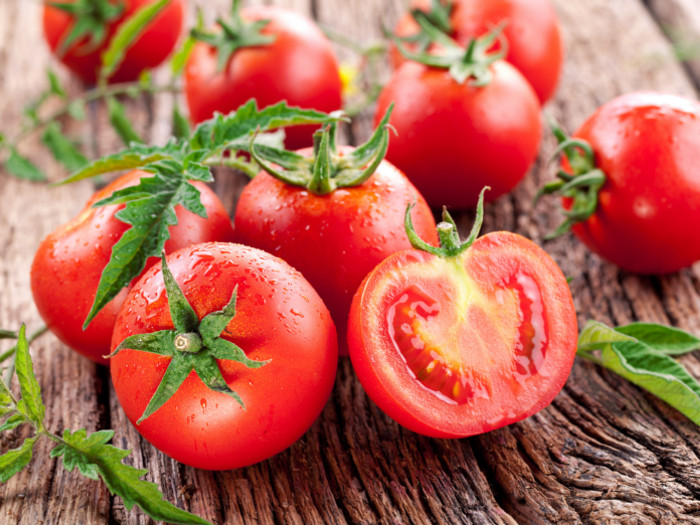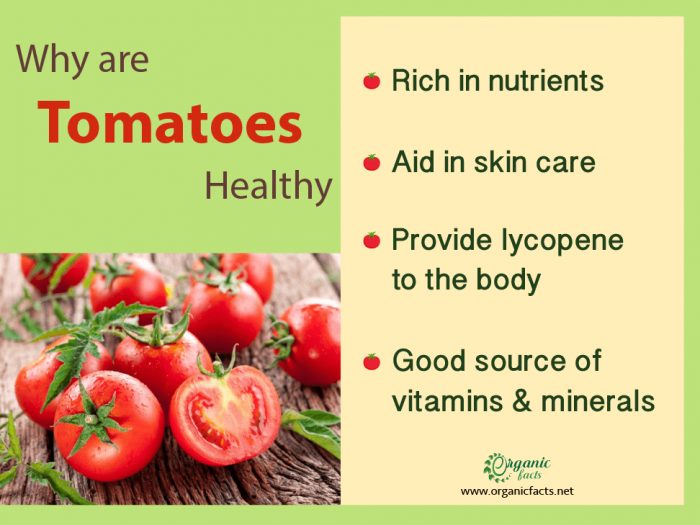Tomato is technically considered a fruit but is generally lumped into the category of vegetables as a practice. Tomatoes form an integral part of cuisines across the globe, especially in the Mediterranean region. Daily consumption of tomatoes can provide a great boost to health, along with improving the flavor of food. You can find them in different foods like pasta, pizzas, ketchup, and various beverages. They are relatively easy to cultivate and grow very quickly, making them a great food source, which is a big reason why tomatoes are a staple food for many nations.
The health benefits of tomatoes may include eye care, good stomach health, and reduced blood pressure. They can help us manage diabetes, skin problems, and urinary tract infections. Furthermore, they may improve digestion, stimulate blood circulation, reduce cholesterol levels, improve fluid balance, protect the kidneys, detoxify the body, prevent premature aging, and reduce inflammation. They are also a rich source of vitamins and minerals and can exert a protective effect against cardiovascular diseases.
What is a Tomato?
The scientific name of tomatoes is Solanum Lycopersicum, and they are believed to be native to Mexico. However, the Spanish colonization of America and Central America caused tomato cultivation to spread. They are an annual nightshade plant and grow in clusters of small to moderately sized, round red fruits. They have soft, pinkish-red flesh and a number of seeds, as well as a slightly sweet taste. They weigh approximately 4 ounces. [1]
Nowadays, tomatoes are grown in countries all over the world and there are thousands of cultivars and varieties that can provide you with unique health benefits. Let’s explore a few of the reasons why they are such a valuable food item for human health.

Garden-fresh juicy tomatoes Photo Credit: Shutterstock
Tomatoes Nutrition Facts
| Serving Size : | |
|---|---|
| Nutrient | Value |
| Water [g] | 94.52 |
| Energy | 18 |
| Energy [kJ] | 74 |
| Protein [g] | 0.88 |
| Total lipid (fat) [g] | 0.2 |
| Ash [g] | 0.5 |
| Carbohydrate, by difference [g] | 3.89 |
| Fiber, total dietary [g] | 1.2 |
| Sugars, total including NLEA [g] | 2.63 |
| Glucose (dextrose) [g] | 1.25 |
| Fructose [g] | 1.37 |
| Calcium, Ca [mg] | 10 |
| Iron, Fe [mg] | 0.27 |
| Magnesium, Mg [mg] | 11 |
| Phosphorus, P [mg] | 24 |
| Potassium, K [mg] | 237 |
| Sodium, Na [mg] | 5 |
| Zinc, Zn [mg] | 0.17 |
| Copper, Cu [mg] | 0.06 |
| Manganese, Mn [mg] | 0.11 |
| Fluoride, F [µg] | 2.3 |
| Vitamin C, total ascorbic acid [mg] | 13.7 |
| Thiamin [mg] | 0.04 |
| Riboflavin [mg] | 0.02 |
| Niacin [mg] | 0.59 |
| Pantothenic acid [mg] | 0.09 |
| Vitamin B-6 [mg] | 0.08 |
| Folate, total [µg] | 15 |
| Folate, food [µg] | 15 |
| Folate, DFE [µg] | 15 |
| Choline, total [mg] | 6.7 |
| Betaine [mg] | 0.1 |
| Vitamin A, RAE [µg] | 42 |
| Carotene, beta [µg] | 449 |
| Carotene, alpha [µg] | 101 |
| Vitamin A, IU [IU] | 833 |
| Lycopene [µg] | 2573 |
| Lutein + zeaxanthin [µg] | 123 |
| Vitamin E (alpha-tocopherol) [mg] | 0.54 |
| Tocopherol, beta [mg] | 0.01 |
| Tocopherol, gamma [mg] | 0.12 |
| Tocotrienol, alpha [mg] | 0.01 |
| Vitamin K (phylloquinone) [µg] | 7.9 |
| Fatty acids, total saturated [g] | 0.03 |
| 16:0 [g] | 0.02 |
| 18:0 [g] | 0.01 |
| Fatty acids, total monounsaturated [g] | 0.03 |
| 16:1 [g] | 0 |
| 18:1 [g] | 0.03 |
| Fatty acids, total polyunsaturated [g] | 0.08 |
| 18:2 [g] | 0.08 |
| 18:3 [g] | 0 |
| Phytosterols [mg] | 7 |
| Tryptophan [g] | 0.01 |
| Threonine [g] | 0.03 |
| Isoleucine [g] | 0.02 |
| Leucine [g] | 0.03 |
| Lysine [g] | 0.03 |
| Methionine [g] | 0.01 |
| Cystine [g] | 0.01 |
| Phenylalanine [g] | 0.03 |
| Tyrosine [g] | 0.01 |
| Valine [g] | 0.02 |
| Arginine [g] | 0.02 |
| Histidine [g] | 0.01 |
| Alanine [g] | 0.03 |
| Aspartic acid [g] | 0.14 |
| Glutamic acid [g] | 0.43 |
| Glycine [g] | 0.02 |
| Proline [g] | 0.02 |
| Serine [g] | 0.03 |
| Sources include : USDA [2] | |
Tomato Calories
The calories in tomatoes differ on the basis of their variety. A 100 g of raw green tomato has about 23 calories whereas a 100 g of orange raw tomato contains 16 calories. Many people also used canned tomato puree or juice, so the calorie count in these versions can be a bit more as there are preservatives in them. [4] [5]
Health Benefits of Tomatoes
The health benefits of tomatoes have been known since ancient times. Let’s discuss the benefits in detail.
Potential Antioxidant Agent
Tomatoes contain a large amount of lycopene, which is a carotenoid and an antioxidant that can be highly effective in scavenging free radicals. This benefit can even be obtained from heat-processed tomato products like ketchup. [6]

Tomatoes are a great addition to any recipe you make, like salads or sandwiches.
Rich Source of Vitamins and Minerals
A single tomato provides about 40 percent of the daily vitamin C requirement. Vitamin C is a natural antioxidant that can prevent free radicals from damaging the body’s systems. It may also contain vitamin A and potassium, as well as iron. Potassium can play a vital role in maintaining nerve health, and iron is essential for maintaining normal blood circulation. Vitamin K1 can also be abundantly found in tomatoes, which is essential for blood clotting and bone health, is also in tomatoes. [7] [8] [9]
May Protect the Heart
Tomatoes rich in lycopene offer substantial cardiovascular benefits, whether consumed in their raw form, as tomato juice or as an ingredient in tomato sauce. A comprehensive analysis of 25 studies revealed that a significant intake of lycopene, combined with elevated levels of this potent antioxidant in the bloodstream. Interestingly, the way we consume tomatoes matters; a combination of tomato sauce and olive oil appears to have a pronounced positive impact on heart health, likely due to the enhanced absorption of lycopene. [10] [11]
Tomatoes also play a pivotal role in managing cholesterol levels. According to a study, consuming tomatoes is associated with lower levels of LDL (low-density lipoprotein) cholesterol, often referred to as the “bad” cholesterol, and higher levels of HDL (high-density lipoprotein) cholesterol, known as the “good” cholesterol. Remarkably, these benefits may rival those of cholesterol-lowering medications. [12]
Moreover, tomatoes are not just a source of lycopene; they are also abundant in other heart-healthy nutrients such as beta-carotene, folate, and flavonoids. Interestingly, tomato juice has demonstrated cardioprotective properties independently of lycopene. [13]
To maximize the therapeutic potential of lycopene, it is advisable to consume it with a moderate amount of dietary fat, as this enhances its absorption.
May Improve Vision
Tomatoes, rich in vitamin A, are essential for maintaining optimal eye health. Vitamin A is a powerful antioxidant that can be formed from an excess of beta-carotene in the body. Eating tomatoes can help to boost your intake of both vitamin A and beta-carotene, which can protect your eyes from age-related macular degeneration (AMD), cataracts, and other eye diseases. [14] [15]
Beta-carotene is a carotenoid pigment that gives tomatoes their red color. It is a precursor to vitamin A, meaning that the body can convert beta-carotene into vitamin A when needed. However, beta-carotene has its own antioxidant benefits, and it is thought that eating a diet rich in beta-carotene may help to reduce the risk of eye diseases even if the body does not convert all of the beta-carotene into vitamin A. [16]
In addition to vitamin A and beta-carotene, tomatoes also contain other nutrients that are important for eye health, such as lutein and zeaxanthin. Lutein and zeaxanthin are carotenoids that are concentrated in the macula, the central part of the retina. According to the American Macular Degeneration Formation and the American Optometric Association, lutein and zeaxanthin help to protect the macula from damage caused by blue light and other environmental factors. [17] [18] [19]
May Aid Digestion
Tomatoes may keep the digestive system healthy by preventing gastrointestinal issues. According to a study, consuming foods abundant in antioxidants, such as tomatoes, can also aid in managing gastritis, an inflammatory condition affecting the stomach lining [20]
Furthermore, they might have a large amount of fiber, which can bulk the bowels and reduce symptoms of constipation. A healthy amount of fiber can help stimulate peristaltic motion in the smooth digestive muscles and may release gastric and digestive juices. This can regulate your bowel movements, thereby improving your overall digestive health and helping protect against health issues.
May Lower Hypertension
Consuming tomatoes frequently can reduce the risk of developing hypertension, also known as high blood pressure. This can be partially due to the impressive levels of potassium found in tomatoes. Potassium is a vasodilator, meaning that it may reduce the tension in blood vessels and arteries, thereby increasing circulation and lowering the stress on the heart by reducing hypertension. [21]
May Manage Diabetes
A study published in the Journal of the American Medical Association indicates that daily consumption of tomatoes can help reduce the oxidative stress of type-2 diabetes. Moreover, lycopene intake may increase the plasma rate of this compound. However, there are more studies required to establish an association between lycopene intake and the risk of developing diabetes. [22]
May Aid in Skin Care
Tomatoes may aid in maintaining healthy teeth, bones, hair, and skin. The topical application of tomato juice is known to cure severe sunburns. Daily consumption can protect the skin against UV-induced erythema. They rank high in the preparation of anti-aging products. Furthermore, an antiperspirant composition for the treatment of hyperhidrosis (excessive sweating) containing tomato as one of the ingredients was patented by Dr. Audrey G. Kunin, certified dermatologist and Chief Creative Officer of DERMAdoctor, Inc. [23] [24]
May Prevent Gallstones
Tomato is a good source of vitamin C and may also help in providing relief from gallstones. There have been various studies to prove their efficacy against many chronic diseases. The antioxidant properties of tomatoes can also be derived from processed foods like ketchup and purees. Daily consumption of tomatoes can fulfill the requirement of vitamins and minerals and exert an overall protective effect on the body. [25]
Word of caution: Tomatoes generally do not pose major side effects to anyone. However, there are certain proteins in tomatoes that are similar to pollen. This means that people with pollen allergies can be more prone to suffering from an allergic reaction after eating tomatoes. The symptoms may include itching, edema, or a scratchy throat. [26] [27]
Quick and Simple Tomato Recipes
This tender vegetable is a great addition to any recipe you make, more so, even salads or sandwiches. Here are some simple tomato recipes.
Creamy Homemade Tomato Basil Recipe
Tomato Basil Salad Recipe
Homemade Tomato Juice Recipe
Are Organic Tomatoes Better?
Organic tomatoes, according to a study at the University of Barcelona, are produced in an environment that has a lower nutrient supply since nitrogen-rich chemical fertilizers are not added. This may lead to the excessive formation of antioxidants such as quercetin and kaempferol in organic tomatoes. [28]
On the other side, chemical-based tomato farming may involve spraying tomatoes with large quantities of pesticides and insecticides. Tomatoes are a highly sprayed crop throughout the world. Therefore, many organic food lovers believe that they are protected from chemical contamination when they eat organic ones instead. Of course, organic farming is good for the environment as well.
